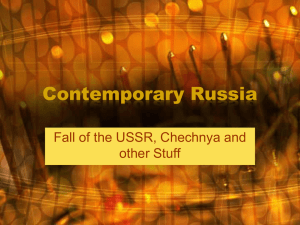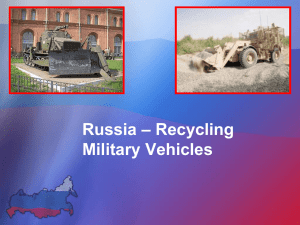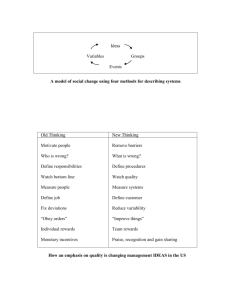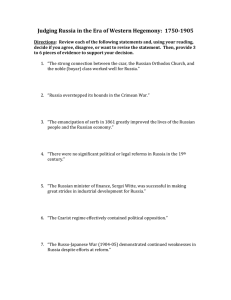Growth of Russian Empire: Expansion & Nationalism
advertisement
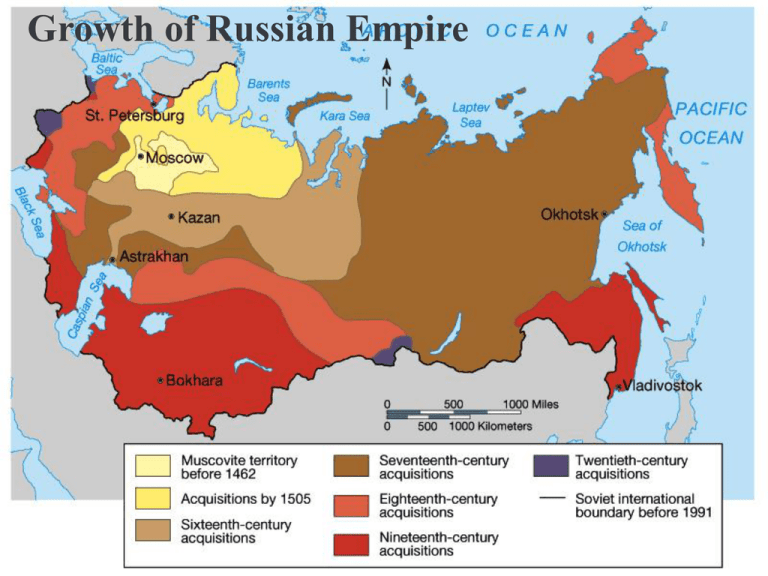
Growth of Russian Empire Russian expansion, 1796-1894 Growth of Russia 1462 : 15,000 mi2 1914 : 8.5 million mi2 Grew avg. 50 mi2 /day to 1/7 of Earth’s landmass, 11 time zones U.S. & Russia Westward (or eastward) expansion Settler colonialism on Native lands Railroads enable settlement End to slavery (or serfdom), 1860s Causes for expansion • Urge to sea (warm-water ports) • Defensive buffer • Global “overseas” imperialism • Plain ole’ greed Land Use Russia Russia In east-west bands, affecting settlement Oil Trans-Siberian railroads in eastern Russia Omsk Russia Empires 1. Homeland -Muscovy origin 2. Ukraine/Belarus• 5 2 1 4 5 3 4 4 5 -Slav, Orthodox 3. Boreal riverine -Fur trade, extraction -Outnumber nonRussian natives 4. Russian settlers -S. Ukraine, S. Siberia belt 5. Nationalistic empire -Non-Slavic republics -Russians administer from cities Barriers to Russian expansion WEST Swedes, Poles, Lithuanians (Invaded by French, Germans) EAST Japanese, Americans (Alaska 1867) SOUTH Ottomans (Turks), Persians (Iranians), British (in India) Nationalism in the Former Soviet Union Russians as % of Empire 80 Ethnic Russian percentage of population 70 60 50 40 30 20 10 0 1719 1917 1989 Lenin on national self-determination • Nationalism of the oppressor vs. Nationalism of the oppressed • Criticized Russian majority nationalism • Independence for Poland, Finland, Baltic states • Union of Soviet Socialist Republics (USSR), 1922 Stalin on nationalism • Ethnic Georgian (Dzhugashvili) but pro-Russian • Feared, repressed ethnic minorities & religions • Russification of minorities (Cyrillic) • Ruled republics through Russified elites, money Stalin on nationalism • Constructed ethnic groups from local identities • Divide-and-rule through ethnic boundaries – “Time bombs” of minorities within republics • Yet boundaries strengthened identity later S.S.R.s Russian Soviet Federated Socialist Republic (RSFSR) _________ Soviet Socialist Republic (SSR) : Ukrainian Byelorussian Georgian Armenian Azerbaijan After World War II: Moldavian Estonian Kazakh Kirghiz Turkmen Tadzhik Uzbek Latvian Lithuanian Ethnic minority areas within S.S.R.s Ethnic minority areas within S.S.R.s (mainly within RSFSR) • Autonomous Soviet Socialist Republic (ASSR) • Autonomous Oblast (Region) • Autonomous Okrug (District) Nagorno-Karabakh Ethnic Armenian region, but part of Azerbaijan; War in 1988-94 Russia successor state to USSR, Dec. 25, 1991 Place name changes: De-Sovietization Leningrad St. Petersburg Gorky Nizhny Novgorod Frunze Bishkek Place name changes: Indigenization Byelorussia Belarus Yakutia Sakha Kishinev Chisinau , Place name changes: Transliteration Gomel Homyel Tadzhikistan Tajikistan Nakhichevan Naxçivan Kirghizstan Kyrgyzstan • Ukraine, Belarus, Kazakstan disarm nukes • Economic, military ties disrupted between republics • Rise of “mafia” economy, crime Aftermath, 1990s “Shock therapy” • Close command industries •Reduce or end subsidies • Privatize industrial economy •High unemployment, inflation, inequality Spatial economy • Winning regions Hub cities Gateway • Losing regions Older military-industrial Agricultural, Resources Ethnic minority Opposition to Yeltsin •Communists & nationalists lament loss of Empire •Slavophile populists mistrust West; often anti-Semitic •Yeltsin tanks fire on Parliament, 1993 • Candidates: Rutskoi, Lebed, Zhirinovsky, Zyuganov Yeltsin’s Demise • Financial crash • Health problems • Drunk as a skunk • Corruption extended to family • Ethnic minority autonomy (soft on Chechens?) Vladimir Putin, 2000-? • Underestimated as Yeltsin puppet • Ex-KGB in Germany; knows West well • Yet also placates “Eurasians,” Soviet memories Chechnya • Won vs. Russia in 1990, 1994-96 • Declared independence • Key Caspian oil pipeline Putin’s ruthless brutality won admirers Russians flatten Grozny, capital of Chechnya, 2000 Authoritarianism returning • Media controls • Centralization in Moscow • Ethnic autonomy lessened • Economic heavy hand ETHNIC REGIONS IN RUSSIA 1992 Federation Treaty Keep Russian Federation together by granting autonomy to ethnic minority regions Chechnya refused to sign, declared independent Tatarstan, Bashkortostan almost refused, got greater autonomy Putin cracked down on Chechens, weakened others, 2000 Northern ethnic regions Russian majority in resource extraction/ Native minority in reindeer Karelia (Finnish) Yamalia Komi Khantia-Mansia Evenkia Taymyria Sahka (Yakutia) Permyakia Nenetsia Koryakia Chukotka Volga/Urals ethnic regions • Surrounded by Russia since 16th century Tatarstan Bashkortostan Mordovia Mari El Chuvashia Udmurtia Tatarstan Turkic Muslim descendants of Tatar nomadic warriors; Now largest minority in Russia; Capital at Kazan Nearly independent 1991; Negotiated treaty relationship with Russia as nation-to-nation Southern Siberia ethnic regions • Buddhist region along Mongol/China border Altaya Buryatia Ust-Orda Aga Tuva Birobijan (Jewish) Tuva (Tyva) Independent 1921-44 ; Tuvans unique culture niq Throat singing in Genghis Blues Buryatia Buryats ethnic Mongols along Lake Baikal North Caucasus ethnic regions of Russia • Predominantly Muslim; some Orthodox, Buddhist • Predominantly Turkic; some Iranian • Fought Russian expansion in mountains North Caucasus ethnic regions of Russia Chechnya Ingushetia Adygea Dagestan North Ossetia Kalmykia Kabardino-Balkaria Karachay-Cherkessia Ethnic minority regions since Federation Treaty, 1992 Russians fear one secession would spread to all Chechens Caucasian-speaking Muslim mountain people ( 1 mil.) Strong clans bitterly resisted 1850s Russian conquest Stalin exiled Chechens, Ingush to Kazakstan, 1944 Return 1957, live in Chechno-Ingushetia republic Declaration 1991 Chechen Communist chiefs backed August coup Air Force Gen. Dudayev declared independence Yeltsin sent troops, but backed down Ingush split from Chechnya, conflict with North Ossetians Chechnya • Plains to north • River, ridges, and Grozny in the middle • Mountains and forest to the south • Effect of geography on security Invasion 1994 Yeltsin shells Chechens & Russians, takes Grozny Rebels driven to mountains; Dudayev killed Key Caspian oil pipeline 30,000 civilians die; half-million displaced War unpopular among Chechen Russians, soldiers’ moms Chechens expand scope; take hostages in Russian hospital Lebed negotiates for independence in 5 years Rebels retake Grozny; Yeltsin withdraws before election; Chechens elect “moderate” Maskhadov victory 1996 Russia invades again, 1999-2000 Lawlessness in Chechnya Apartment bombings in Russia (Chechens or KGB?) Putin prime minister; brutally retakes Grozny Russians flatten Grozny, capital of Chechnya, 1999 Rebels driven south again into mountains, Pankisi Gorge (Georgia); Basayev leads terrorist attacks Tensions grow, 2001-03 Pres. Putin wins U.S. support after 9/11, in return for bases; Chechens portrayed as Al-Qaeda Moscow theater hostagetaking ends in disastrous raid Chechen rebel raids; Russian tensions with Georgia Moscow gas raid kills 121 hostages, 2002 (U.S. trainers in Pankisi Gorge) Rebels see “referendum” for limited autonomy as sham Beslan, 2004 Rebels take 1,000 hostages at grade school in North Ossetia Explosions, shootout kill 330 + (half kids) in “Russia’s 9/11.” Basayev suspected, but Russians kill Maskhadov Fighting in Chechnya, suicide bombings in Russia continue Environment in Russia USSR was worse than West • 2.5 X air pollution of U.S. (per GNP) • 20% water unsafe • 1/3 of arable land affected by acid rain • Etc., etc. Why USSR was worse • Heavy industry • Expand agriculture • “Inexhaustible” resources • Legitimacy, self-sufficiency through technology • Sacrifice for defense Why USSR was worse • Leadership technicians; questioning prevented • Little free opposition • Secrecy; lack of enforcement • Central planning insensitive • Only capitalism harms nature WATER Aral Sea • Once the 4th largest inland body of water in the world. A series of dams was built to irrigate cotton. • Aral Sea reduced to about 25% of its 1960 volume, 4x salinity wiped out the fishery. • Pollutants became airborne as dust, causing significant local health problems. Aral Sea Interbasin water transfers (river diversions) Kara Kum Canal Amu Darya Size of Aral Sea Environmental damage estimated at $1.25 -$2.5 billion a year. Caspian Sea Western, Russian oil and gas Companies in Caspian Basin Caspian Sea Caspian Seal in Kazakstan Caspian sturgeon and its caviar Oil spill off Baku, Azerbaijan Dnieper R. Ukraine Sea of Dniester R. Azov Moldova Crimea Danube R. Romania Don R. BLACK SEA Bulg. Bosporus Turkey Russia Georgia Sea of Azov Eutrophication (Algae growth) Metals plant on Dnieper River Lake Baikal Environmental objections to paper mills as early as 1960s AIR & LAND Kola Peninsula, NW Russia Donbass & Kuzbass Donbass coal fields, E. Ukraine Kuzbass coal fields, W. Siberia Kalmykia European Buddhist Mongols Desertification Chemicals/ Salinization Oil development Sakha (Yakutia) • Siberian indigenous • Coal, metals mining • Logging Clear-cutting in Siberia Japanese and South Korean companies take advantage of “fire sale” International campaign to protect Amur Tiger along Chinese border Noril’sk nickel smelter Arctic Haze and Acid Rain WAR Acid rain, Mining, Nuclear subs scuttled Kola Peninsula Sverdlovsk anthrax, 1979 Bioweapons disaster, 79 cases (66 dead) in Yeltsin’s district Uranium mining Roma (Gypsy) kids playing on radioactive mill tailings from Soviet uranium mine in Pécs, Hungary Soviet nuclear tests in Kazakstan Genetic defects near Semey (Semipalatinsk) Kazaks protest Kyshtym waste disaster, 1957 Orphans – Explosion at Soviet weapons factory forces evacuation of over 10,000 people in Ural Mts. – Area size of Rhode Island still uninhabited; thousands of cancers reported Novaya Zemlya NUCLEAR POWER Chernobyl disaster, April 1986 400 million people exposed in 20 countries “It Can’t Happen Here” • U.S. reaction to Chernobyl, 1986 – Blamed on Communism, graphite reactor • Also Soviet reaction to Three-Mile Island, 1979 – Blamed on Capitalism, pressurized-water reactor • No technology 100% safe – Three-Mile Island bubble almost burst 8,000 deaths in 14 years 3.5 million sick, one/third of them children Chernobyl’s political fallout • Secrecy stimulated glasnost, environmental opposition • Stimulated nationalism in Ukraine, Belarus, other republics that lost clean-up workers. • Questioning of the heart of technocratic power • USSR collapsed within 5 years. Positives since end of USSR • Democratization: NGOs, data • Decentralization: local sensitivity • Deindustrialization of old areas • Expanded national parks • Protection laws stronger by 1993 Negatives since end of USSR • Financial difficulties; jobs stressed • Reduced monitoring, enforcement • Increased affluence, cars, waste • Profit motive; foreign firms • Putin dismantled agency, 2002 Other positives in Eastern Europe • Ecological dissidents in transition • Increased spending • Pollution control technology • Loss of markets • Entry into E.U. standards RAIPON Russia's recent socio-economic crisis has led to a breakdown of most of the supply and transportation system in the remote areas. Having been made dependent on modern infrastructure and product distribution, the people now find themselves left alone with Rising mortality, Lacking supplies, Lacking medical care, Lacking economic means, Lacking legal expertise, to deal with the situation….. RAIPON Diseases such as tuberculosis and alcoholism, Prevalent malnutrition, High infant mortality, Death rate exceeding birth rate (for some ethnic groups), High suicide rate, Devastation of Native lands and water resources by industry, Lack of implementation of relevant laws, Waste of financial means for development programs, Lack of legal capacity, No legal security, Loss of control over social and economic organisation, Cultural and linguistic decimation. 10 of 41 indigenous peoples are on the edge of extinction. Taiga/Boreal forest •North Russia/Siberia •Acidic podzol soils poor for farming •Conifers •Half of Former USSR (all in Russia) Tundra (treeless) zone •Permafrost (frozen subsoil) •Indigenous herders •Slavs extract resources Rivers East/North •Ob’-Irtysh •Yenisei-Angara •Lena-Aldan •Amur-Ussuri •Kolyma •Lake Baikal Ranges •Kolyma •Aldan •Syan •Altai •Yablonovy Seas •White Japan •Barents Bering •Kara Okhotsk •E. Siberian Laptev YanoKolymsky Amur RiverSakhalin Island Kamchatka PeninsulaOkhotsk Sea xxxxx Xxxxxxx Xxxxxxxx Xxxxxxx xxxxxxxxx xxxxx Xxxxxxx Xxxxxxxx Xxxxxxx xxxxxxxxx Chukotka Russian, Chukchi, Yup’ik, etc. 160,000 (1989) 10% Native (in reindeer, caribou) Russians, etc. in mining, timber, administration 55,000 (2004) Larger wealth gap, Temporary work zone, Democracy of majority Chukotka Diomede Islands in Bering Strait; Yup’ik met on ice border in Cold War Détente, 1970s Chukotka Environmental cross-border cooperation since 1991
